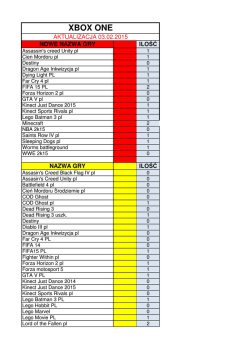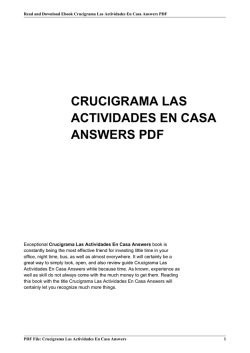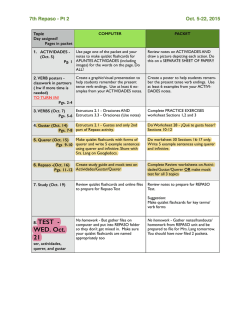
Introducción a Máquinas Simples y Motorizadas Avanzando con
Introducción a Máquinas Simples y Motorizadas Avanzando con Máquinas Simples y Motorizadas 2009686 2009687 8+ años Con estas actividades los estudiantes obtienen un conocimiento básico de máquinas simples, estructuras y mecanismos. Las actividades presentan 37 actividades de modelos de principios, 14 actividades principales, incluyendo actividades de extensión, y seis tareas de solución de problemas. Las animaciones en Flash presentan las actividades. Incluyen notas para el profesor, hojas de trabajo para los estudiantes y glosario. 10+ años Estas actividades permiten a los estudiantes conocer a profundidad las máquinas simples, mecanismos, estructuras y ventaja mecánica. Incluye 38 actividades de modelos de principios, cuatro actividades principales, incluyendo actividades de extensión, y ocho tareas de solución de problemas. Las actividades se presentan a los estudiantes mediante videos de la vida real. Incluyen notas para el profesor, hojas de trabajo para los estudiantes y glosario. Aprendizaje esperado Aprendizaje esperado • Investiga los principios de las máquinas simples, mecanismos y estructuras • Experimenta con fuerzas equilibradas y desequilibradas • Experimenta con fricción • Captura, almacena y transfiere la energía del viento • Mide distancia, tiempo, velocidad y peso • Calibra balanzas • Investiga las fuerzas motorizadas, movimiento, velocidad y potencia • Investiga los principios de las máquinas simples, mecanismos y estructuras • Ventaja mecánica • Fuerzas equilibradas y desequilibradas • Equilibrio • Polispasto • Efecto de la fuerza en un objeto • Experimenta con fricción • Calcula velocidad, distancia, tiempo y peso • Identifica las variables dependientes e independientes Student Worksheet Teacher’s Notes Beam Balance Beam Balance Name(s): Science Build the Beam Balance and Loads Date and Subject: (Building Instruction 15A and 15B to page 9, step 9) • Forces • Make sure the arm moves up and down freely and the Beam Balance is in a state of equilibrium • Simple machines – Lever Technology • Assembling components • Construct simple machines • Evaluating • Mechanical advantage • Properties of materials Engineering Why is it in a state of equilibrium? • Test and evaluate before making improvements Mathematics • Determine percent of error • Develop, analyze, and explain methods for Place the load and efforts as shown and use the formulas for levers to find the mechanical advantage and to explain what happens. solving problems involving First, observe the mechanical advantage of Beam Balance A. proportions, Then use the formula for calculating the amount of effort needed to lift a given load to explain why the Beam Balance is in a state of equilibrium. levels of precision • Solve problems involving scale factors, using ratio and proportion Next, follow the same procedure for Beam Balance B and C. Use this formula to help explain why each model is balanced Effort x length of effort arm = Load x length of load arm. Vocabulary • Equilibrium • Fulcrum • Levers • Load • Weight Mechanical advantage Weight of load Load distance from fulcrum Weight of effort Effort distance from fulcrum A Other materials required • Measuring tape • Calibrated weighing machine (page 10, step 10) B (page 11, step 11) C (page 12, step 12) LEGO and the LEGO logo are trademarks of the/sont des marques de commerce de/son marcas registradas de LEGO Group. ©2009 The LEGO Group. Beam Balance 95 Teacher’s Notes Connect LEGO and the LEGO logo are trademarks of the/sont des marques de commerce de/son marcas registradas de LEGO Group. ©2009 The LEGO Group. 100 Student Worksheet Beam Balance How much does it weigh? Your challenge is to use the balance to work out the weight of assembly A. A Put assembly A one arm and balance it with preassembled weights on the other arm. Use these positions to calculate the weight of assembly A. Use the calibrated weighing machine to check your accuracy. Build your own set of weights from LEGO® parts and test their accuracy. Calculated weight of load Measured weight of load Percentage of accuracy A The simplest weighing machine is a beam balance. The original form of a balance consisted of a beam with a fulcrum at its center. A change of weigh on either side of the balance will change the beams positioning and effect the balance achieved. You will build a model Beam Balance and investigate how its function is influenced by changes in weight and position. Hint: Find out how accurate your calculation was by finding the difference between the actual and calculated weight. Then divide the difference with the actual weight and multiply it by 100. Explain your findings: LEGO and the LEGO logo are trademarks of the/sont des marques de commerce de/son marcas registradas de LEGO Group. ©2009 The LEGO Group. edutecnologica.com.ar 96 LEGO and the LEGO logo are trademarks of the/sont des marques de commerce de/son marcas registradas de LEGO Group. ©2009 The LEGO Group. 101 Los colores y diseños decorativos de los elementos pueden variar.
© Copyright 2025



